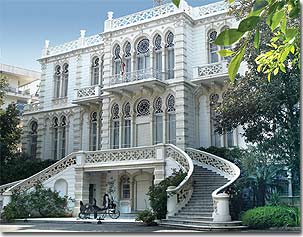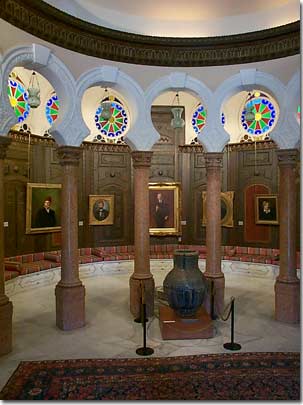Galleries and art training opportunities by Frieda Howling
The Nicolas Sursock Museum can be thought of as a small, precious jewel in the midst of a city of conglomeration. When it opened its doors in 1961 with an exhibit of works of contemporary Lebanese artists, it set precedent for cultural events.

Architecturally, the building was then a fine example of a private home of a person of means and a collector of art. Of particular interests and charm was the ground floor with its typical Arabic sitting room that included the marble water fountain, the arches and painted wood walls and ceilings. The upper floor, which could be reached in a small elevator or by way of a narrow stairway, consisted of a series of small rooms. Obviously these had been the bedrooms. Above doors leading to balconies, beautiful stained glass windows caught one's eyes. The setting was unique and the first exhibit a success, as were the many exhibits which followed, such as an Oriental rug exhibition and a Rodin exhibit. The physical functioning of the museum was poor, however. The space was too broken up, the lighting was inadequate. Through the efforts of a hardworking, responsible committee many changes have taken place both in the physical plant and in the organization of the running of the museum.
When I visited the museum in 1975, I found that it had been transformed to a flexible and scientific museum. The architectural changes were visible but did not detract from the original charm of the exterior and interior of the building. An addition was built in the back of the building. This part housed mainly the administrative offices and storage spaces. The Arabic salon had been kept in its original form. Appropriately, it housed the museum's Islamic works of art in ceramics, silver, local icons, and books. The second floor had been made into one large exhibition room with moveable walls so it could be partitioned off as the need arose.

The ceiling had been opened so excellent daylight could flood the area through the windows. A good lighting system was installed as well as an alarm system, complete air conditioning, and a large elevator for transporting heavy and large art objects. These changes enabled the museum to bring exhibitions of international value to Beirut such as the exhibit of «Treasures from Ecuador » the 1974 Islamic Art Exhibit, and the planned 1976 exhibit on the history of glass, starting, naturally, with the Phoenician glass. (Because of the war, this exhibit had to be postponed.)
The museum also housed a library, published catalogues of its major exhibitions, and sponsored a lecture program free of charge. This was to encourage schools and the public in general to take advantage of cultural exposure.
With the growth and the development of the museum the Lebanese artist gained prestige. Annually the museum sponsored an exhibition of works by Lebanese artists. A permanent collection of contemporary Lebanese art was started, and the committee purchased up to three pieces of art for the permanent collection from the annual exhibit. Artists represented at that time were: Michel El Mir, Omar Onsi, Georges Guv, Aref Rayess, John Haddian, Elie Kanaan, H. Torrossian, Chafic Abboud, Levon Moumjian. Madi Hussein, Halim Jurdak, Nadia Saikali, Stelio Scamanga, Mounir Najm, Paul Guiragossian, Anton Asfar, Lotti Adaimi, Juliana Seraphim, Khalil Zgaib, Sophie Yaramian, Juman Beyazit, Simon Baltaxe, Martayan, Mohamed Sakr, Zavan Haditzian, Saloua Rouada Choucair, and Viola Kassab. Also included was the influential French artist and teacher George Cyr.
Another non-profit exhibition place available to the Lebanese artists was the spacious Exhibition hall in the ministry of Tourism building on Rue Hamra. The exhibition gallery at the American University of Beirut was another prime space. The Beirut College for women also sponsored exhibitions in their Sheikh Zaid Exhibition hall in the Fine Arts Building. Many professional art galleries had opened since 1962 when Gallery One was the first gallery to open and to represent contemporary Lebanese artists with a permanent collection. Although many of the painters were avant-garde in expressing their ideas, some were still a little skeptical and did not quite understand that it was in their best interest to have the backing of a gallery. Many of them still preferred to exhibit in the local hotel lobbies. No matter where they took place, any season's openings were always exciting and stimulated a healthy spirit of competition. Most art galleries showed both Lebanese and European artists. Gallery Deco 27 specialized in graphic art.
The following were popular galleries in Beirut in 1975:
Al- Riwaq – Ramlet El Baida, Delta Gallery, Alex Manoukian Art Center, Gallery One, Centre D'Art, L'Amateur gallery, Centre D'Art 2, Le Point Gallery, Contact Gallery, Modul Art Gallery, Contemporaine gallery, Studio 27, Dar El Fan Gallery, Vendome Gallery, Deco 27.
The desire for a career in art and art-related fields, or the hope becoming an artist drew many young people to art schools and universities with good art departments nearly everywhere in the world. Lebanon was no exception.
Established schools had to struggle for years since it was difficult to survive in a society that was not quite ready to provide these career opportunities either to the professional artists or to those in art-related fields. The students were quickly discouraged or they went abroad to seek serious studies in art. When Alexis Boutros established the Academie Libanaise des Beaux Arts in 1943, he was fortunate to get the dynamic leadership of Cesar Gemayel as the director of the School of Painting .
The Academie Libanaise des Beaux Arts became part of the Lebanese University .
Many Lebanese artists received their formal training at this academy where they received a diploma after four years. Its program offered majors in four specialized areas: Painting, Architecture, Interior Decoration, and Theater. In 1966-67 it expanded into the area of graphic Art which was introduced by Halim Jurdak after his return from Paris . All of the present faculty members are specialists in their areas and bring their professional expertise to the student body.
The American university of Beirut and the Beirut College for Women both offered a Bachelor of Arts degree after a four year program in the visual arts which provided for specialization during the last two years in painting, sculpture, ceramics, jewelry, printmaking, or crafts. The Art Department of Beirut (AUB) played a major role in the training of Lebanese artists, as well as artists from all over the Middle East . The art department was established in 1955 and, unfortunately, had to go into a hiatus when it was closed in 1975 due to the civil war. During its existence, it offered excellent opportunities of studies in the arts to many aspiring young artists.
Among the artists represented in this book, seven of them received an important part of their training from the highly qualified professional staff of the art department at AUB. They included Mustafa Farrouk, Omar Onsi, Farid Haddad. William H. Bardawil, Adel Saghir, Stelia Scamanga and Aida Marini. Several artists were also involved in the teaching program at the University. They were Michel Basbous and Helem Khal. Stelio Scamanga was on the faculty of the School of Architecture and Mustafa Farrouk taught art at Section Secondaire of the American university.
The Beirut College for Women (now known as the Lebanese American university), offered an excellent curriculum in the fine arts under the direction of Mehranguise Irani, chair of the Art Department . Interior Decorating was added to the basic offerings. In 1963-64 the visiting painter from California , Boit Morse, spent some time on the campus teaching advanced students in painting and lecturing in art appreciation. In an interview by Genevieve Maxwell of the Daily Star, he said «Never have I seen such vitality as is coming out of this school. I have found, to my surprise very open minds and an enormous amount of enthusiasm for contemporary painting here. «The new Fine Arts building was a credit to the development of the university.
Several smaller private schools of art existed which catered mainly to the amateur artists, the persons interested in self-expression thought a visual arts medium. The Center of Fine Arts fulfilled this need. This school was originally known as the Saleeby School of Arts because it was established by Khalil Saleeby. It offered classes in drawing and painting for both adults and children. The Hamaoui Arts Center was established in 1968 by Haidar Hamaoui as a vocational art school. The serious student could receive a certificate after he passed through the four year program which stressed the basics of perspective, color, light and shadow, composition, and finishing touches. The student who was a hobbyist painter ranged in age from the very young to ninety. Both schools fulfilled the need of a public looking for self-improvement, although the possibility of leading to professionalism was not excluded.
Copyright Art in Lebanon, The development of Contemporary Art in Lebanon 1930 - 1975